Enron Case Study: Analyzing CEO's Role, Ethics, CSR, Stakeholders
VerifiedAdded on 2023/06/11
|8
|2329
|256
Case Study
AI Summary
This case study examines the Enron scandal, focusing on the role of the CEO and the ethical failures that led to the company's collapse. It highlights the CEO's fiduciary failures, high-risk accounting practices, and undisclosed off-the-books activities. The study emphasizes the significance of ethics and corporate social responsibility, particularly in maintaining transparency and accountability. It also explores the importance of multi-stakeholder engagement, including internal stakeholders like employees, shareholders, and managers, and external stakeholders such as customers, suppliers, and the government. The analysis concludes that ethical practices and responsible corporate governance are crucial for a company's sustainability and positive market image, while unethical activities can lead to financial ruin and loss of stakeholder trust. Desklib offers more case studies and solved assignments for students.

Case Study
Paraphrase This Document
Need a fresh take? Get an instant paraphrase of this document with our AI Paraphraser
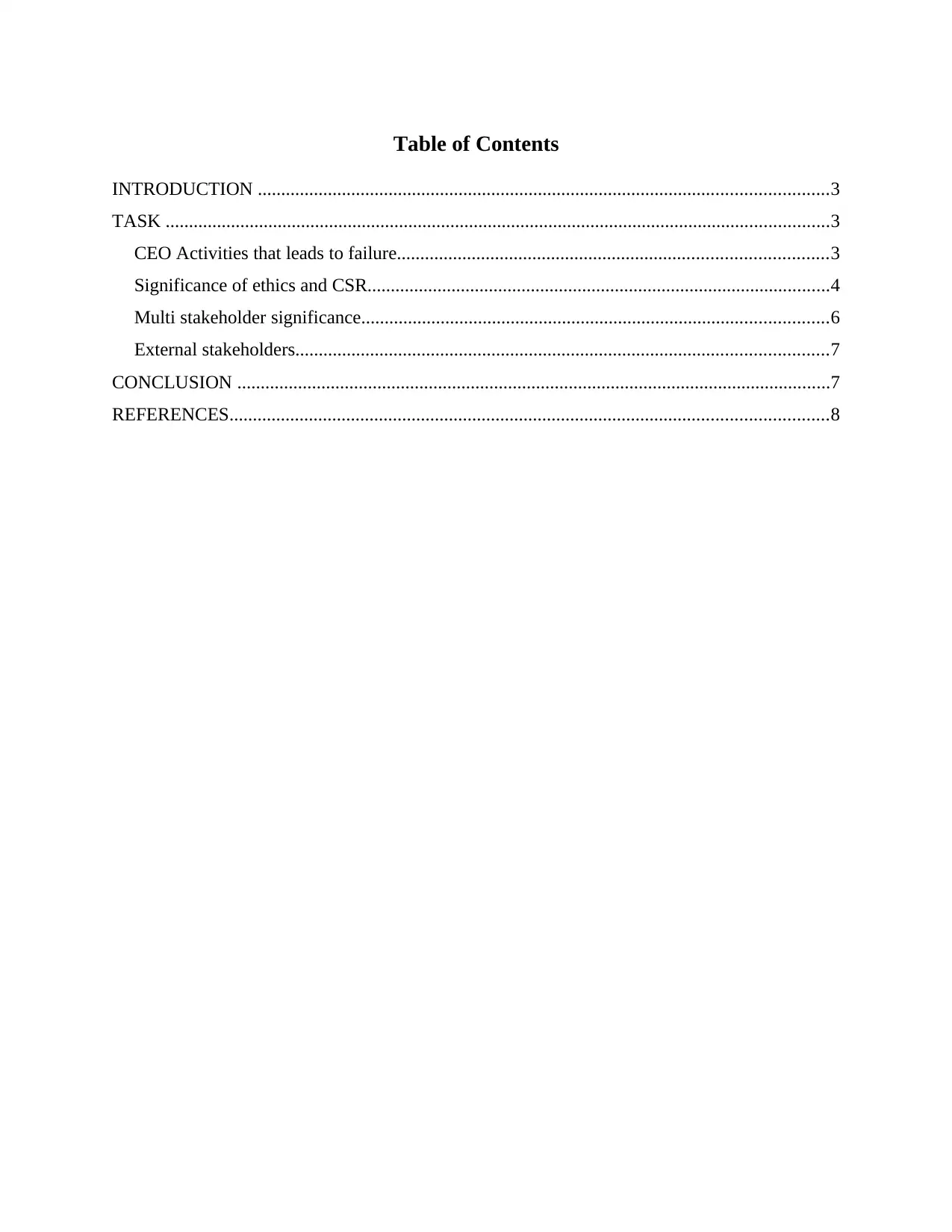
Table of Contents
INTRODUCTION ..........................................................................................................................3
TASK ..............................................................................................................................................3
CEO Activities that leads to failure............................................................................................3
Significance of ethics and CSR...................................................................................................4
Multi stakeholder significance....................................................................................................6
External stakeholders..................................................................................................................7
CONCLUSION ...............................................................................................................................7
REFERENCES................................................................................................................................8
INTRODUCTION ..........................................................................................................................3
TASK ..............................................................................................................................................3
CEO Activities that leads to failure............................................................................................3
Significance of ethics and CSR...................................................................................................4
Multi stakeholder significance....................................................................................................6
External stakeholders..................................................................................................................7
CONCLUSION ...............................................................................................................................7
REFERENCES................................................................................................................................8
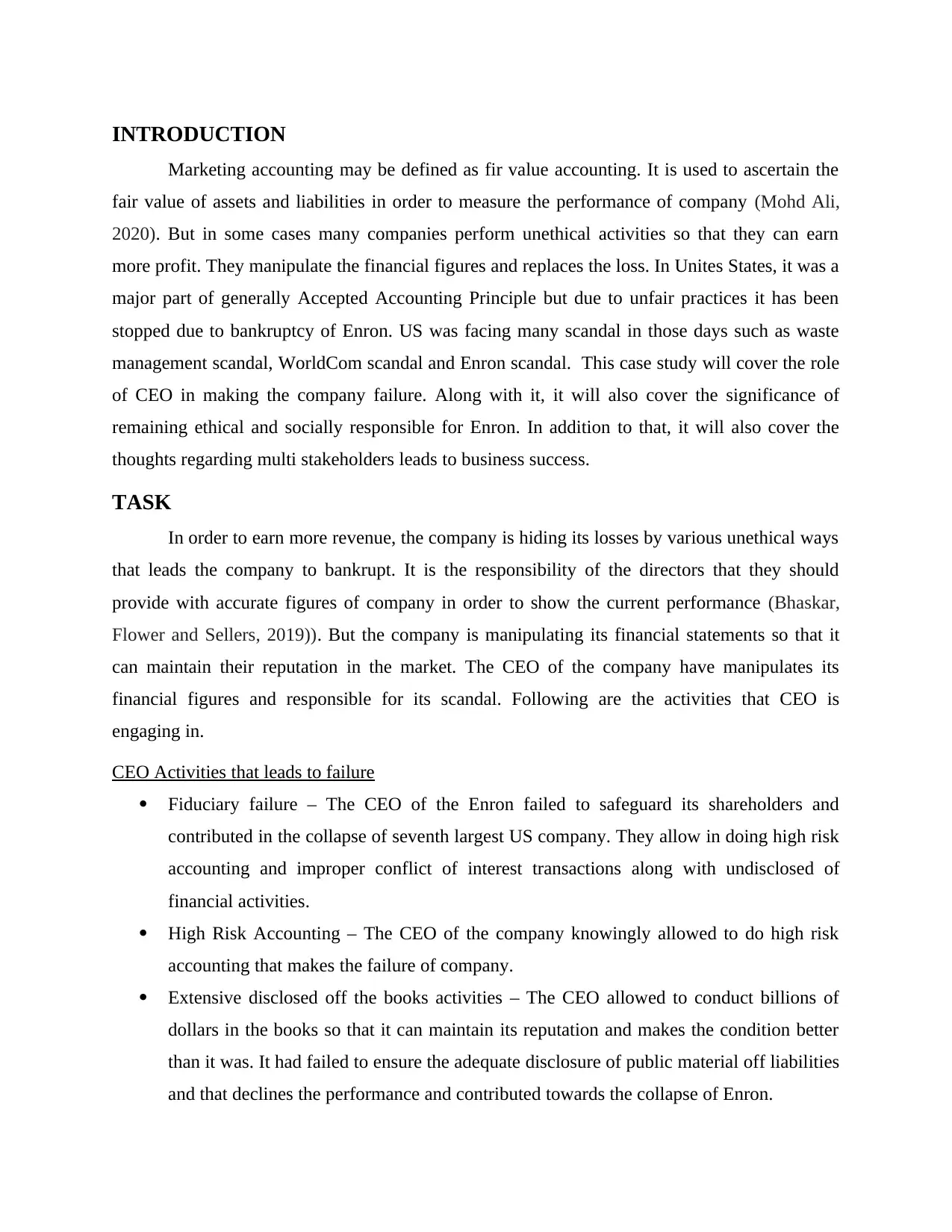
INTRODUCTION
Marketing accounting may be defined as fir value accounting. It is used to ascertain the
fair value of assets and liabilities in order to measure the performance of company (Mohd Ali,
2020). But in some cases many companies perform unethical activities so that they can earn
more profit. They manipulate the financial figures and replaces the loss. In Unites States, it was a
major part of generally Accepted Accounting Principle but due to unfair practices it has been
stopped due to bankruptcy of Enron. US was facing many scandal in those days such as waste
management scandal, WorldCom scandal and Enron scandal. This case study will cover the role
of CEO in making the company failure. Along with it, it will also cover the significance of
remaining ethical and socially responsible for Enron. In addition to that, it will also cover the
thoughts regarding multi stakeholders leads to business success.
TASK
In order to earn more revenue, the company is hiding its losses by various unethical ways
that leads the company to bankrupt. It is the responsibility of the directors that they should
provide with accurate figures of company in order to show the current performance (Bhaskar,
Flower and Sellers, 2019)). But the company is manipulating its financial statements so that it
can maintain their reputation in the market. The CEO of the company have manipulates its
financial figures and responsible for its scandal. Following are the activities that CEO is
engaging in.
CEO Activities that leads to failure
Fiduciary failure – The CEO of the Enron failed to safeguard its shareholders and
contributed in the collapse of seventh largest US company. They allow in doing high risk
accounting and improper conflict of interest transactions along with undisclosed of
financial activities.
High Risk Accounting – The CEO of the company knowingly allowed to do high risk
accounting that makes the failure of company.
Extensive disclosed off the books activities – The CEO allowed to conduct billions of
dollars in the books so that it can maintain its reputation and makes the condition better
than it was. It had failed to ensure the adequate disclosure of public material off liabilities
and that declines the performance and contributed towards the collapse of Enron.
Marketing accounting may be defined as fir value accounting. It is used to ascertain the
fair value of assets and liabilities in order to measure the performance of company (Mohd Ali,
2020). But in some cases many companies perform unethical activities so that they can earn
more profit. They manipulate the financial figures and replaces the loss. In Unites States, it was a
major part of generally Accepted Accounting Principle but due to unfair practices it has been
stopped due to bankruptcy of Enron. US was facing many scandal in those days such as waste
management scandal, WorldCom scandal and Enron scandal. This case study will cover the role
of CEO in making the company failure. Along with it, it will also cover the significance of
remaining ethical and socially responsible for Enron. In addition to that, it will also cover the
thoughts regarding multi stakeholders leads to business success.
TASK
In order to earn more revenue, the company is hiding its losses by various unethical ways
that leads the company to bankrupt. It is the responsibility of the directors that they should
provide with accurate figures of company in order to show the current performance (Bhaskar,
Flower and Sellers, 2019)). But the company is manipulating its financial statements so that it
can maintain their reputation in the market. The CEO of the company have manipulates its
financial figures and responsible for its scandal. Following are the activities that CEO is
engaging in.
CEO Activities that leads to failure
Fiduciary failure – The CEO of the Enron failed to safeguard its shareholders and
contributed in the collapse of seventh largest US company. They allow in doing high risk
accounting and improper conflict of interest transactions along with undisclosed of
financial activities.
High Risk Accounting – The CEO of the company knowingly allowed to do high risk
accounting that makes the failure of company.
Extensive disclosed off the books activities – The CEO allowed to conduct billions of
dollars in the books so that it can maintain its reputation and makes the condition better
than it was. It had failed to ensure the adequate disclosure of public material off liabilities
and that declines the performance and contributed towards the collapse of Enron.
⊘ This is a preview!⊘
Do you want full access?
Subscribe today to unlock all pages.

Trusted by 1+ million students worldwide
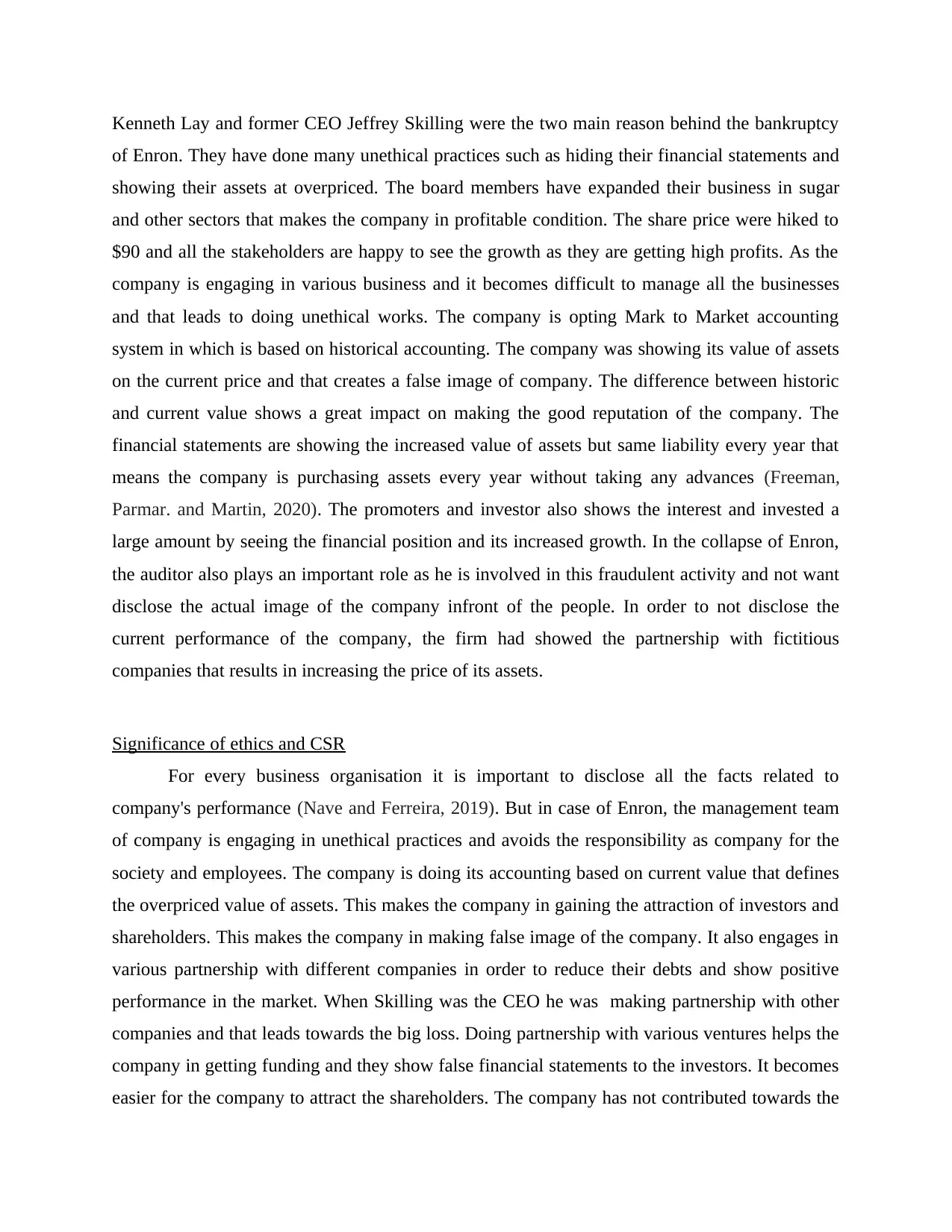
Kenneth Lay and former CEO Jeffrey Skilling were the two main reason behind the bankruptcy
of Enron. They have done many unethical practices such as hiding their financial statements and
showing their assets at overpriced. The board members have expanded their business in sugar
and other sectors that makes the company in profitable condition. The share price were hiked to
$90 and all the stakeholders are happy to see the growth as they are getting high profits. As the
company is engaging in various business and it becomes difficult to manage all the businesses
and that leads to doing unethical works. The company is opting Mark to Market accounting
system in which is based on historical accounting. The company was showing its value of assets
on the current price and that creates a false image of company. The difference between historic
and current value shows a great impact on making the good reputation of the company. The
financial statements are showing the increased value of assets but same liability every year that
means the company is purchasing assets every year without taking any advances (Freeman,
Parmar. and Martin, 2020). The promoters and investor also shows the interest and invested a
large amount by seeing the financial position and its increased growth. In the collapse of Enron,
the auditor also plays an important role as he is involved in this fraudulent activity and not want
disclose the actual image of the company infront of the people. In order to not disclose the
current performance of the company, the firm had showed the partnership with fictitious
companies that results in increasing the price of its assets.
Significance of ethics and CSR
For every business organisation it is important to disclose all the facts related to
company's performance (Nave and Ferreira, 2019). But in case of Enron, the management team
of company is engaging in unethical practices and avoids the responsibility as company for the
society and employees. The company is doing its accounting based on current value that defines
the overpriced value of assets. This makes the company in gaining the attraction of investors and
shareholders. This makes the company in making false image of the company. It also engages in
various partnership with different companies in order to reduce their debts and show positive
performance in the market. When Skilling was the CEO he was making partnership with other
companies and that leads towards the big loss. Doing partnership with various ventures helps the
company in getting funding and they show false financial statements to the investors. It becomes
easier for the company to attract the shareholders. The company has not contributed towards the
of Enron. They have done many unethical practices such as hiding their financial statements and
showing their assets at overpriced. The board members have expanded their business in sugar
and other sectors that makes the company in profitable condition. The share price were hiked to
$90 and all the stakeholders are happy to see the growth as they are getting high profits. As the
company is engaging in various business and it becomes difficult to manage all the businesses
and that leads to doing unethical works. The company is opting Mark to Market accounting
system in which is based on historical accounting. The company was showing its value of assets
on the current price and that creates a false image of company. The difference between historic
and current value shows a great impact on making the good reputation of the company. The
financial statements are showing the increased value of assets but same liability every year that
means the company is purchasing assets every year without taking any advances (Freeman,
Parmar. and Martin, 2020). The promoters and investor also shows the interest and invested a
large amount by seeing the financial position and its increased growth. In the collapse of Enron,
the auditor also plays an important role as he is involved in this fraudulent activity and not want
disclose the actual image of the company infront of the people. In order to not disclose the
current performance of the company, the firm had showed the partnership with fictitious
companies that results in increasing the price of its assets.
Significance of ethics and CSR
For every business organisation it is important to disclose all the facts related to
company's performance (Nave and Ferreira, 2019). But in case of Enron, the management team
of company is engaging in unethical practices and avoids the responsibility as company for the
society and employees. The company is doing its accounting based on current value that defines
the overpriced value of assets. This makes the company in gaining the attraction of investors and
shareholders. This makes the company in making false image of the company. It also engages in
various partnership with different companies in order to reduce their debts and show positive
performance in the market. When Skilling was the CEO he was making partnership with other
companies and that leads towards the big loss. Doing partnership with various ventures helps the
company in getting funding and they show false financial statements to the investors. It becomes
easier for the company to attract the shareholders. The company has not contributed towards the
Paraphrase This Document
Need a fresh take? Get an instant paraphrase of this document with our AI Paraphraser

well being of the employees and directors. They are not involved in any decision and agree upon
every decision. The board of members have the right to inspect the accounts of the company. But
they show carelessness and they focus on checking the prices of shares instead of checking and
inspecting the accounts. It is the duty of the members of the company to regularly check the
accounts of the company but members of Enron have avoided their responsibility. They should
be aware about the company's performance whether the company is making profit or suffering
loss. But rather than inspecting and checking the accounts they trusted their officer Jeffrey
Skilling. The other non ethical activity in which the company is involving is corporate
governance in which it defines that the company should fair and true financial image of the
company and do not manipulate with the figures (Brunton, Eweje and Taskin, 2017). Actual
statements are to be shown and no other changes are to be done for unfair means. But the
company is secretly hiding its losses and presenting its false image in front of its stakeholders
and investors. It is the responsibility of the company that it should serve to the customers with
ethical means and do not manipulate its information. As they are trying to hide their debts and
were doing partnerships so that they can maintain a feasible image in the market. By
manipulating the financial figures, the prices of its shares has raised to $90 and that creates a
favourable image in the market. The share price were increasing by 52 weeks. The auditor of
Enron is also engaging in this fraudulent activity as it do not want to disclose the correctness of
the financial statements of the company and despite of saying of new vice president, it did not
discloses and eventually the company becomes bankrupt. An investigation has been conducted
that opens all the facts and figures of company that it was suffering loss of $638 billion.. Earlier
the company was serving better to the society band doing all the activities ethically but later on
when it wants to expand its business, it starts engaging in various sectors of business in order to
be Jack of all business. But that was the biggest mistake that leads the company in bankruptcy.
Then to maintain a decent position and hold the existing investors it starts doing its work
unethically such as hiding the liabilities from investors showing the prices of assets and liabilities
at overpriced and showing fake revenue (Muttakin, Khan and Mihret, 2018). This makes the
company in degrading its image in the market and finally becomes bankrupt.
every decision. The board of members have the right to inspect the accounts of the company. But
they show carelessness and they focus on checking the prices of shares instead of checking and
inspecting the accounts. It is the duty of the members of the company to regularly check the
accounts of the company but members of Enron have avoided their responsibility. They should
be aware about the company's performance whether the company is making profit or suffering
loss. But rather than inspecting and checking the accounts they trusted their officer Jeffrey
Skilling. The other non ethical activity in which the company is involving is corporate
governance in which it defines that the company should fair and true financial image of the
company and do not manipulate with the figures (Brunton, Eweje and Taskin, 2017). Actual
statements are to be shown and no other changes are to be done for unfair means. But the
company is secretly hiding its losses and presenting its false image in front of its stakeholders
and investors. It is the responsibility of the company that it should serve to the customers with
ethical means and do not manipulate its information. As they are trying to hide their debts and
were doing partnerships so that they can maintain a feasible image in the market. By
manipulating the financial figures, the prices of its shares has raised to $90 and that creates a
favourable image in the market. The share price were increasing by 52 weeks. The auditor of
Enron is also engaging in this fraudulent activity as it do not want to disclose the correctness of
the financial statements of the company and despite of saying of new vice president, it did not
discloses and eventually the company becomes bankrupt. An investigation has been conducted
that opens all the facts and figures of company that it was suffering loss of $638 billion.. Earlier
the company was serving better to the society band doing all the activities ethically but later on
when it wants to expand its business, it starts engaging in various sectors of business in order to
be Jack of all business. But that was the biggest mistake that leads the company in bankruptcy.
Then to maintain a decent position and hold the existing investors it starts doing its work
unethically such as hiding the liabilities from investors showing the prices of assets and liabilities
at overpriced and showing fake revenue (Muttakin, Khan and Mihret, 2018). This makes the
company in degrading its image in the market and finally becomes bankrupt.
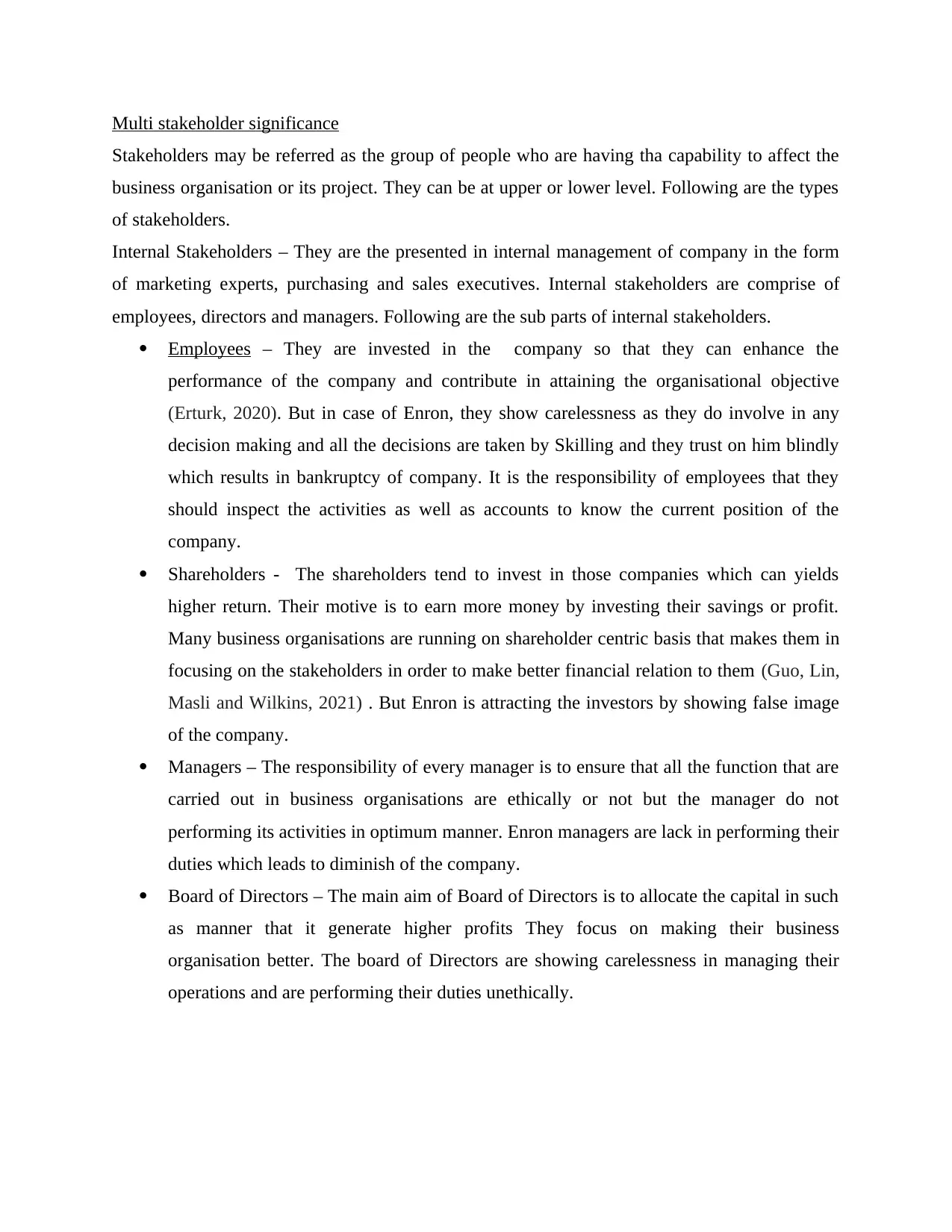
Multi stakeholder significance
Stakeholders may be referred as the group of people who are having tha capability to affect the
business organisation or its project. They can be at upper or lower level. Following are the types
of stakeholders.
Internal Stakeholders – They are the presented in internal management of company in the form
of marketing experts, purchasing and sales executives. Internal stakeholders are comprise of
employees, directors and managers. Following are the sub parts of internal stakeholders.
Employees – They are invested in the company so that they can enhance the
performance of the company and contribute in attaining the organisational objective
(Erturk, 2020). But in case of Enron, they show carelessness as they do involve in any
decision making and all the decisions are taken by Skilling and they trust on him blindly
which results in bankruptcy of company. It is the responsibility of employees that they
should inspect the activities as well as accounts to know the current position of the
company.
Shareholders - The shareholders tend to invest in those companies which can yields
higher return. Their motive is to earn more money by investing their savings or profit.
Many business organisations are running on shareholder centric basis that makes them in
focusing on the stakeholders in order to make better financial relation to them (Guo, Lin,
Masli and Wilkins, 2021) . But Enron is attracting the investors by showing false image
of the company.
Managers – The responsibility of every manager is to ensure that all the function that are
carried out in business organisations are ethically or not but the manager do not
performing its activities in optimum manner. Enron managers are lack in performing their
duties which leads to diminish of the company.
Board of Directors – The main aim of Board of Directors is to allocate the capital in such
as manner that it generate higher profits They focus on making their business
organisation better. The board of Directors are showing carelessness in managing their
operations and are performing their duties unethically.
Stakeholders may be referred as the group of people who are having tha capability to affect the
business organisation or its project. They can be at upper or lower level. Following are the types
of stakeholders.
Internal Stakeholders – They are the presented in internal management of company in the form
of marketing experts, purchasing and sales executives. Internal stakeholders are comprise of
employees, directors and managers. Following are the sub parts of internal stakeholders.
Employees – They are invested in the company so that they can enhance the
performance of the company and contribute in attaining the organisational objective
(Erturk, 2020). But in case of Enron, they show carelessness as they do involve in any
decision making and all the decisions are taken by Skilling and they trust on him blindly
which results in bankruptcy of company. It is the responsibility of employees that they
should inspect the activities as well as accounts to know the current position of the
company.
Shareholders - The shareholders tend to invest in those companies which can yields
higher return. Their motive is to earn more money by investing their savings or profit.
Many business organisations are running on shareholder centric basis that makes them in
focusing on the stakeholders in order to make better financial relation to them (Guo, Lin,
Masli and Wilkins, 2021) . But Enron is attracting the investors by showing false image
of the company.
Managers – The responsibility of every manager is to ensure that all the function that are
carried out in business organisations are ethically or not but the manager do not
performing its activities in optimum manner. Enron managers are lack in performing their
duties which leads to diminish of the company.
Board of Directors – The main aim of Board of Directors is to allocate the capital in such
as manner that it generate higher profits They focus on making their business
organisation better. The board of Directors are showing carelessness in managing their
operations and are performing their duties unethically.
⊘ This is a preview!⊘
Do you want full access?
Subscribe today to unlock all pages.

Trusted by 1+ million students worldwide

External stakeholders
Customers – The customers always wants to get the product at cheaper rate. As the
company is providing better product service to the customer but facing many issues and
challenges. So the company should not continue its business in an unethical way.
Suppliers – As the company becomes largest producer thus it wants to spread its horizon
in many areas and that is the reason it wants to expand its operations in different field. It
is important to understand for the supplier not to enter in every field or it may suffer loss.
Governments – The United States government are not checking the functions of Enron
and not performing auditing functions regularly. If it is doing early then the investors
money cannot be lost. So it is needed to audit and inspects of accounts regularly so that it
can save interest of promoters.
CONCLUSION
From the above case study it was concluded that companies should disclose their
financial records correctly so that it can maintain a positive image in the market. The main
reason for the Enron bankruptcy is unauthorised and unethical practices that leads the company
to collapse. Skilling , the CEO is responsible as he was liable for doing joint partnerships with
different ventures. The main aim is to hide its debts and and show the value of assets and
liabilities at higher value. The employees are not even inspecting their accounts and the auditor is
also not disclosing the truthfulness of financial statements. Despite of suffering losses, the
company wants to manage its reputation in market so it involves in doing unethical activities.
The governments should take effective measures in order to reduce these scandals.
Customers – The customers always wants to get the product at cheaper rate. As the
company is providing better product service to the customer but facing many issues and
challenges. So the company should not continue its business in an unethical way.
Suppliers – As the company becomes largest producer thus it wants to spread its horizon
in many areas and that is the reason it wants to expand its operations in different field. It
is important to understand for the supplier not to enter in every field or it may suffer loss.
Governments – The United States government are not checking the functions of Enron
and not performing auditing functions regularly. If it is doing early then the investors
money cannot be lost. So it is needed to audit and inspects of accounts regularly so that it
can save interest of promoters.
CONCLUSION
From the above case study it was concluded that companies should disclose their
financial records correctly so that it can maintain a positive image in the market. The main
reason for the Enron bankruptcy is unauthorised and unethical practices that leads the company
to collapse. Skilling , the CEO is responsible as he was liable for doing joint partnerships with
different ventures. The main aim is to hide its debts and and show the value of assets and
liabilities at higher value. The employees are not even inspecting their accounts and the auditor is
also not disclosing the truthfulness of financial statements. Despite of suffering losses, the
company wants to manage its reputation in market so it involves in doing unethical activities.
The governments should take effective measures in order to reduce these scandals.
Paraphrase This Document
Need a fresh take? Get an instant paraphrase of this document with our AI Paraphraser
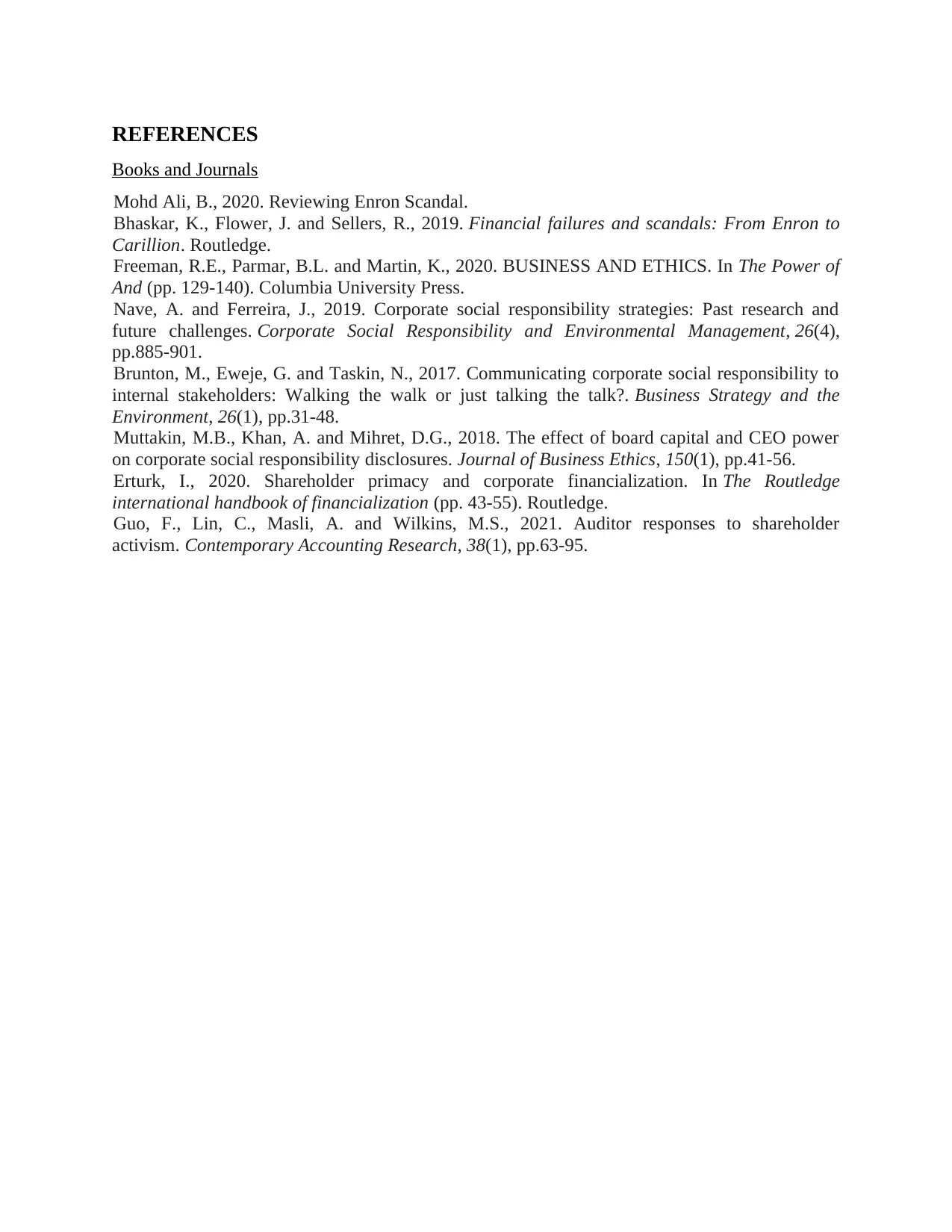
REFERENCES
Books and Journals
Mohd Ali, B., 2020. Reviewing Enron Scandal.
Bhaskar, K., Flower, J. and Sellers, R., 2019. Financial failures and scandals: From Enron to
Carillion. Routledge.
Freeman, R.E., Parmar, B.L. and Martin, K., 2020. BUSINESS AND ETHICS. In The Power of
And (pp. 129-140). Columbia University Press.
Nave, A. and Ferreira, J., 2019. Corporate social responsibility strategies: Past research and
future challenges. Corporate Social Responsibility and Environmental Management, 26(4),
pp.885-901.
Brunton, M., Eweje, G. and Taskin, N., 2017. Communicating corporate social responsibility to
internal stakeholders: Walking the walk or just talking the talk?. Business Strategy and the
Environment, 26(1), pp.31-48.
Muttakin, M.B., Khan, A. and Mihret, D.G., 2018. The effect of board capital and CEO power
on corporate social responsibility disclosures. Journal of Business Ethics, 150(1), pp.41-56.
Erturk, I., 2020. Shareholder primacy and corporate financialization. In The Routledge
international handbook of financialization (pp. 43-55). Routledge.
Guo, F., Lin, C., Masli, A. and Wilkins, M.S., 2021. Auditor responses to shareholder
activism. Contemporary Accounting Research, 38(1), pp.63-95.
Books and Journals
Mohd Ali, B., 2020. Reviewing Enron Scandal.
Bhaskar, K., Flower, J. and Sellers, R., 2019. Financial failures and scandals: From Enron to
Carillion. Routledge.
Freeman, R.E., Parmar, B.L. and Martin, K., 2020. BUSINESS AND ETHICS. In The Power of
And (pp. 129-140). Columbia University Press.
Nave, A. and Ferreira, J., 2019. Corporate social responsibility strategies: Past research and
future challenges. Corporate Social Responsibility and Environmental Management, 26(4),
pp.885-901.
Brunton, M., Eweje, G. and Taskin, N., 2017. Communicating corporate social responsibility to
internal stakeholders: Walking the walk or just talking the talk?. Business Strategy and the
Environment, 26(1), pp.31-48.
Muttakin, M.B., Khan, A. and Mihret, D.G., 2018. The effect of board capital and CEO power
on corporate social responsibility disclosures. Journal of Business Ethics, 150(1), pp.41-56.
Erturk, I., 2020. Shareholder primacy and corporate financialization. In The Routledge
international handbook of financialization (pp. 43-55). Routledge.
Guo, F., Lin, C., Masli, A. and Wilkins, M.S., 2021. Auditor responses to shareholder
activism. Contemporary Accounting Research, 38(1), pp.63-95.
1 out of 8